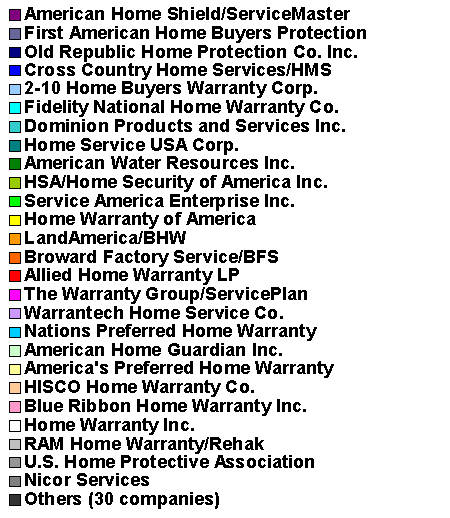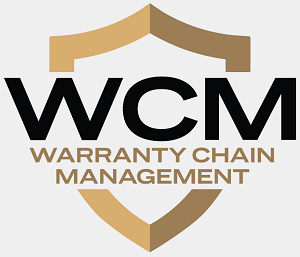Home Warranty Market Share:While American Home Shield continues to dominate, electrical and water utilities are shaking things up with the growth of their wire and pipe protection services. And despite a continuing multi-year dip in home sales, the home warranty industry set a record this year with $1.5 billion in premiums paid by consumers.
Home warranties are a most curious invention. Strictly speaking, they are neither warranties, nor do they cover homes. Instead, they are service contracts that cover the contents of a home, specifically the heating and cooling systems and other major appliances.
There are companies that sell both home warranties and warranties on homes. Best known, perhaps, is 2-10 Home Buyers Warranty Corp., which sells a ten-year structural warranty, general liability insurance and other risk management services to builders of new homes, and which sells renewable one-year service contracts for a home's systems and appliance to owners of existing homes.
The first is an example of what in other industries would be called a product warranty, a factory warranty, an OEM warranty, or perhaps a manufacturer's warranty. It's normally managed by the builder himself, but some find the prospect of outsourcing the warranty management task to a company such as 2-10 quite appealing. The outside company takes the calls, arranges the repairs, manages the contractors, does the paperwork, and handles the payments. And the builder builds.
Warranty vs. Service Contract
The other business, 2-10's "systems and appliance warranty" business, is an example of what we're calling a home warranty, but which elsewhere might be called an extended warranty, a service plan, a home service warranty, or a service contract. It's priced and sold separately from the home, and is typically employed by the sellers of an existing home and their realtor to reassure the eventual buyers of a home that they're not walking into a money pit.
So let's keep that separation in mind this week. We last covered the home builders' warranty business in the September 24 newsletter. We began this series of snapshots for the home warranty industry with the November 5 newsletter.
This is our final newsletter of 2009, and the last in a series of seven about the home warranty industry. Next year, we will begin with a series of snapshots of the vehicle service contract industry, followed by tours of the appliance, electronics, and computer segments of the extended warranty industry. By the end of the tour, we should have a comprehensive census of the whole industry, which until now has been largely undocumented.
One Large Pie
Home warranties are a $1.5 billion business in the U.S., as measured by Warranty Week estimates, growing in 2009 even in the face of unprecedented contractions in the housing market. Home warranties depend on the resale of existing homes for sustenance, and there just haven't been a lot of home sales on 2008 or 2009. But even there we're expecting growth, using extrapolated ten-month National Association of Realtors statistics to project a slight gain in total 2009 sales of existing single-family homes.
In 2009, Warranty Week estimates that the home warranty industry in the U.S. grew by a slim 2%, up from $1.47 billion in 2008. The market leader by far is American Home Shield, a division of the ServiceMaster Co., which also owns the Terminix, TruGreen, and Merry Maids brands of home service providers.
Through the first nine months of 2009, American Home Shield has reported $490.3 million in home warranty revenue, up 8.9% from the same period of 2008. We're estimating a fourth quarter total of about $130 million for the company, which is actually down 6% from 2008 levels, and a calendar year 2009 revenue total of $620 million. That represents a staggering 41% of the market share of the 2009 U.S. home warranty industry.
Figure 1
U.S.-based Home Warranty Industry
Gross Premiums Paid, 2009
(percent of a $1.5 billion total)
The biggest problem with this pie chart is how the slices get real small real fast. American Home Shield has $620 million, or a 41% share of the market, followed by First American Home Buyers Protection with $160 million, or 11%. Old Republic Home Protection Co. Inc. has $125 million or 8.3%. The various brands of Cross Country Home Services together have $90 million or 6% market share. 2-10 Home Buyers Warranty's systems and appliance business has $80 million or 5.3%. Fidelity National Home Warranty Co. has $65 million or 4.3%. And that, ladies and gentlemen, is fully 76% of the U.S.-based home warranty industry.
The Others
Besides those six market leaders, there are at least 50 other companies we identified as being in the home warranty industry in 2009, but their collective market share is only $360 million, or 24%. We tried to represent as many of them as possible on the chart above, but as the slices got thinner we ran out of space for the labels, and then we ran out of colors.
So forgive us if the last 30 or so companies on the list fade to gray. Half of them are the Internet-only home warranty scams that never pay claims and are here today and gone tomorrow -- usually hours before the county sheriff padlocks the doors and the state attorney general freezes their bank accounts.
The other half are small and local businesses that are happy with their small and local footprints, which rely heavily on positive local word-of-mouth and the personal recommendations of local realtors. How to tell them apart? Call and ask to visit them in person at their office to sign the contract. Those who depend on their anonymity to help them flee from angry customers will never consent to that.
It's funny. As soon as we published our report on the Nationwide Home Warranty scam last month, some angry ex-customers began to spread the news that they had discovered the company's real address to be 2711 Coney Island Avenue, Second Floor, Brooklyn NY 11235. They also reported that Champion Home Warranty was indeed sharing that office space with Nationwide, and that the home we photographed for the November 5 newsletter was owned by the in-laws of a top company executive.
So we returned to the Flatlands of Brooklyn three weeks ago, and found a pair of rough-looking "dem 'n' doze" types taking a smoking break outside the front door of the office building, which had no company name on it. They said they worked for a debt collection agency, but they couldn't remember the name of it. Then they went back in, carefully locking the door behind them.
If we went to visit the alleged offices of Mutual Home Warranty, National Home Protection Inc., Choice Home Warranty, or United Home Warranty, we'd probably find the same two guys smoking outside, forgetting the name of their employer before cutting their break short. Well, maybe not National Home Protection: they went out of business before the New York Attorney General imposed a $900,000 fine last week. But maybe it's not so funny. Scams like these give the whole industry a bad name, just like the "expiring warranty" telemarketers did to the vehicle service contract industry.
Back to the Real Industry Report
Besides those six market leaders, there are at least a dozen companies with home warranty revenues in the range of $5 million to $50 million a year. Several of these are major electrical and water utilities, which sell water, sewer, and wire protection plans to homeowners, sometimes in conjunction with appliance repair service contracts. Some are priced at a few dollars per month, while others scale up to the typical $400-a-year range found with full-blown home warranty plans.
In the chart above, we included two of the top utilities with in-house offerings -- Dominion Products and Services Inc., part of Dominion Resources Inc., and American Water Resources Inc., a subsidiary of the American Water Works Company Inc. Also in the line protection market are established extended warranty players such as Cross Country and The Warranty Group (through Virginia Surety Co.).
Home Service USA Corp., meanwhile, acts as a home warranty administrator for more than a dozen other utilities, including FirstEnergy Corp. and United Water. It is a subsidiary of the UK-based company HomeServe plc, which sells a suite of home warranty-like services they call "home emergency insurance."
Together, these utilities and utilities' administrators control an emerging segment of the U.S. home warranty industry that collects at least $160 million from homeowners to protect their wires and pipes and the appliances linked to them. This is in contrast to the $1.34 billion in home warranties sold directly to homeowners last year, usually with the help of a realtor, and usually while the home is on the market.
Dependence on Existing Home Sales
Existing home sales are the oxygen on which home warranties depend. Typically, the realtor handling the sale suggests that the seller should remove some clutter, install brighter light bulbs, and get themselves a home warranty. The goal of the warranty is to reassure the prospective buyer that the home's appliances and heating/cooling systems are not about to take their last breath, or if they are, that at least they will be repaired or replaced.
According to the National Association of Realtors, however, existing one-family home sales peaked in the United States back in 2005, at a level of 6.18 million units. In Figure 2 below we've extrapolated the association's partial-year data to come up with a full-year estimate of 4.4 million sales for 2009. And based on today's encouraging news about existing home sales, that may turn out to be an under-estimate. But the point is that home sales have been in a deep trough for the past three years. This isn't a recession that started last fall.
Figure 2
U.S.-based Existing Home Sales
Single-Family Homes Sold, 2003-2009
But still, an upturn is an upturn, and whether the glass is half full or half empty, at least it's filling back up. In the absence of home sales to latch onto, home warranty companies have placed greater emphasis on renewals and on selling directly to customers whose homes are not on the market. However, we estimate that the renewal market showed almost no growth in 2009, and that all the $30 million growth came from linkages to existing home sales.
Other Major Home Warranty Companies
Home Security of America Inc., which sells the HSA Home Warranty, has operated since 1984 out of its headquarters in Madison, Wisconsin. In other states, the company does business under the names Home Security Association Inc.; HSA Home Warranty Inc.; Home Security Association of Florida Inc.; Home Security of Wisconsin; Home Security Insurance Association; and Home Security Association of Virginia Inc. This has led to some confusion as to whether the company is part of Cross Country Home Services, which also sells home warranties under the names HMS Home Warranty; HomeServe; HomeSure of America Inc.; Homesure of Virginia Inc.; and HomeSure Services Inc. But, we've been assured they are separate, and so HSA's $31 million market share estimate is separate from Cross Country's $90 million estimate.
Home Warranty of America Inc. is an Illinois-based home warranty company that we've estimated at $26 million in 2009. It does business in all states except North Carolina, though its main markets are Illinois and Texas. Speaking of Texas, there are several companies on our list that specialize in the Lone Star State: Allied Home Warranty LP, at $7 million; Nations Preferred Home Warranty Inc., which we've estimated at $4.5 million; OneGuard Home Warranties, which we're estimating at $500,000; Everything Residential LP, which we've estimated at $420,000; and Southwest Warranty Corp., which we've estimated at $220,000.
In California, which is by far the top state market for home warranties, the major players are the six national market leaders. However, there are also a few California-only market players, among them HISCO Home Warranty of San Diego, which we've estimated at $2.6 million; and RAM Home Warranty/Rehak Associates Mobile Services Inc., which we have at $2 million. There's also Buyers Home Warranty Co./LandAmerica Home Warranty, which we estimate did $20 million this year (some of it outside of California) despite the bankruptcy of its parent company.
Home Warranties, Installations and Repairs
In Florida, Service America Enterprise Inc. plies the streets in its ubiquitous bright yellow vans, providing not only repair services under home warranties but also customer-pays one-time appliance repairs and replacement installations. Service America also provides carpet cleaning and plumbing services, and will clear gutters, install HVAC equipment, and "tune-up" air conditioning equipment. We're estimating the home warranty segment of their business to be worth $30 million in 2009, but the company's total revenue may be three times as large.
Broward Factory Service, despite a Florida-sounding name, actually also does business in Georgia, Nevada, and Texas, as well as in Florida. We're estimating their nationwide business at $8.4 million. American Home Guardian Inc., despite having a national-sounding name, does business primarily in Arizona, Nevada, and Texas. America�s Preferred Home Warranty Inc., despite another national-sounding name, does business mostly in Michigan, Ohio, and Indiana, as well as in the Carolinas. We estimate each of these two companies at $3 million.
Finally, we wanted to begin to make up for seven years without home warranty market reports by running one chart containing seven years of market size estimates. In Figure 3 below, we've added up all the annual revenue estimates for all the companies identified above, across the past seven years. It's a down payment on what we hope will turn out to be a series of charts that documents the growth of the extended warranty industry over the past seven years.
Figure 3
U.S.-based Home Warranty Industry
Gross Premiums Paid, 2003-2009
(annual estimates in US$ millions)
Compared to the data in Figure 2, this just doesn't seem right. Why didn't the market turn down with home sales? Not only is 2009 the best year ever for home warranty revenue, but 2008 is the second-best. And the only dip of the decade was in 2007. How can this be?
There are two primary reasons. First, the utilities are drawing in new customers with their line protection/home warranty services, and while they're only 11% of the market now, they were much less a few years ago. And these are mostly new customers, not homeowners trading down from $400-a-year policies. Second, industry pacesetter American Home Shield's really bad year was 2007, when revenue was at least $50 million below trend. In comparison, 2006 was close to what was expected, and the revenue record AHS set in 2008 is sure to be broken when its annual report is filed at the end of March.
Missing Companies?
Besides all that, is there anything missing? Are any of the estimates so far off that they need to be repaired or replaced? Please send your suggestions to change(at)warrantyweek.com. Your comments will be kept confidential unless you choose otherwise.
As mentioned, this is our last newsletter for 2009. We're snowed in anyhow, facing the whitest Christmas holiday for many years in the New York City area. Good thing the Internet doesn't need de-icing or snow chains to deliver the news. This also concludes our seventh full year of publishing Warranty Week. And as always, we want to wish all of our readers a happy, healthy, and prosperous new year. We'll be back on January 7 with the first of many snapshots of the vehicle service contract industry.
|














